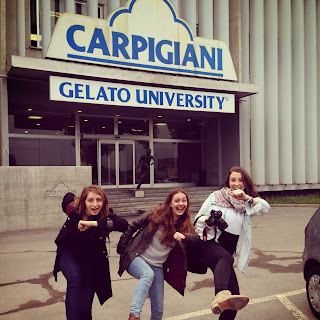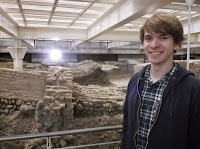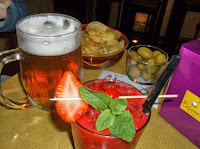Somehow or other, I've stumbled through my two months in Bologna and am moving on to Rome on Saturday, so it's probably time for an update on the actual reason for me being here:
the food my
internship.
My tasks as an intern have ranged from the basic to the bizarre, and my success at coping with them has similarly varied. I'm finally getting the hang of foreign keyboards and feel much more confident with my spoken German and Italian, but the jury is out on whether this is due to a tangible improvement, or more just the fact I've given up caring about whatever horribly embarrassing mistakes I'm making and everyone else has given up trying to correct me. Unfortunately I can't rule out the latter. I did realise some way into an email exchange with a colleague that I'd been addressing him as a female.
But learning to swallow your pride and getting on with it is a rite of passage during year abroad, and you have to be able to stride confidently into any and all opportunities for practicing 'the language', whether this means chatting away to old ladies at the bus stop (check), burdening shopkeepers with your complaints about Italian bureaucracy (check) or jumping at the chance to answer the office phone and speak to clients, even when sometimes it turns out to be your colleague's bemused mother (check - oops).
It turns out there's no more effective way to learn a new bit of vocab than getting it completely, hilariously wrong the first time around. In a country where the inability to roll your 'r's can result in asking for minced dog rather than mincemeat, the occasional awkward conversation is inevitable. Two gems of wisdom I learnt the hard way: frozen food doesn't have
preservativi in it, because that means condoms, not preservatives (if we're being picky, I think it can actually mean both, but from experience is best avoided), and if you fail to pronounce both the 'n's in the word
penne, you'll find yourself referring to a certain part of the male anatomy which you probably don't want to be telling new Italian friends you love to eat.
It's not just the language barrier to contend with; there's a whole host of tiny but suddenly vital details which are completely different in the Italian workplace, from the keyboards to which kind of coffee is acceptable to have on your coffee break. Apparently cappuccinos are strictly for breakfast only, and my colleagues didn't even try to suppress their horrified expressions the first (and last) time I had one at my desk. The Italian directness takes some getting used to as well, and they normally weren't shy to point out any mistakes I made, in my language, coffee choice or otherwise. I was asked to change one of my poster designs for the Institut, because the picture I used - a standard Clipart-style image of smiley children having the time of their lives in a classroom - had "too many different ethnicities, and Italians won't relate to it. We don't have political correctness in Italy." It makes sense from a marketing perspective of appealing to your target audience, but I can't imagine being told something like that in an English office.
Another unexpected hurdle came when I was asked to update the office accounts. Having given up both Maths and IT at the earliest possible moment in my school career, this isn't exactly my strong point, but I was willing to dust off my skills, and thought I could at least navigate the basics of Microsoft Excel. I thought wrong, and ended up spending a frustratingly long time failing to get a column of costs to add up automatically, hardly the most difficult of tasks. After around 30 minutes of self-doubt, wishing I'd spent Year 9 IT lessons doing something other than the Impossible Quiz, and eventual desperate googling with search terms along the lines of 'Excel sum not working why do Italian computers hate me waaahh', I realised that =SUM needs to become =SOMMA in Italy. Turns out Cady Heron was wrong, math isn't the same in every language.
The majority of my time was spent assisting the Cultural Director, who organises events to promote Germany and German culture in Italy. I've helped to set up some of the art and photography exhibitions, concerts, readings and shows which have been going on at the Institut. Although the Bologna branch of the Goethe Institut is small, it was exciting to be involved in these events, which attracted far more interest than I'd expected - probably due to Bologna being so full of students.
The usual repertoire for sorting out these events is as follows; contact the performers, artists or whoever else is involved to finalise details, write and send out a press release, create a programme, done. But for a German chamber music concert last weekend, our boss decided to crank the workload up a notch, requesting that the song lyrics be put together into a booklet with translations in Italian alongside them. Fine, except that while some of these were easily googlable, others were less so, and I had to devote several mornings to honing my skills in translating
Brahms lyrics into Italian. I didn't attend the concert to see how my efforts went down with the audience, but in the likely case of discrepancies/errors, I'm claiming poetic licence.
Overall, in true chaotic Italian style, my job's been a bit of a mixed bag, but I feel I've slotted into the Italian working world with ease...OK, maybe not. I still stick out like a sore thumb with an English accent, and the job's had its difficult, dull and downright embarrassing moments, but for the most part it's been interesting, and has taught me a lot; a few valuable lessons, and many more things I never thought I needed to know, and probably didn't. As a leaving present, my colleagues gave me a book about the history of the Goethe Zentrum, which will be a nice reminder of my first fumbled foray into Italian life, and my 2 months working for the association.









.JPG)
.JPG)
.JPG)





































